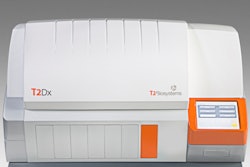Is your portable radiography machine a bacterial breeding ground? Israeli researchers who examined portable x-ray units at their hospital found inadequate levels of infection control practice among equipment operators and also signs of drug-resistant bacterial contamination on the surfaces of a number of systems.
Proper infection control has received increasing attention as the incidence of nosocomial infections rises. Of particular concern is methicillin-resistant Staphylococcus aureus (MRSA), a staph infection that can be contracted from exposure to contaminated surfaces -- such as those in hospitals. Some 20% of intensive care unit (ICU) patients have been infected by drug-resistant bacteria, with most of these infections coming from ICU staff due to inadequate hand hygiene, according to published research.
A group of researchers led by Dr. Phillip Levin of Hebrew University-Hadassah Medical School in Jerusalem focused specifically on infection control practices of radiographers (radiologic technologists) operating portable x-ray units, as these personnel frequently come to the ICU but aren't exposed to educational activities within the ICU unit. The study was published in the August issue of Chest (2009, Vol. 136:2, pp. 426-432).
Bacterial vectors?
Radiographers operating portable machines can be unwitting vectors for the spread of drug-resistant bacteria if adequate infection control procedures aren't followed. Radiologic personnel move from patient to patient acquiring x-ray images, and bacteria can be left on the surface of the radiography unit, to be spread to the next patient, according to the researchers.
Levin and colleagues focused their study on three areas: the infection control procedures followed during chest radiographs in the ICU, whether drug-resistant bacteria are transferred to radiography machines, and whether education and better infection control practices could reduce bacterial colonization of portable x-ray systems.
In the first stage of the study, the researchers developed a list of 14 infection control procedures, and over the course of two months noted whether the procedures were followed during image acquisition. The procedures included steps such as using gloves and alcohol-based hand cleaner, and hand-washing prior to patient contact.
Next, Levin and colleagues obtained culture samples from the surfaces of x-ray machines before and after morning radiography rounds, specifically seeking Gram-negative bacteria resistant to antibiotics such as ceftazidime, ceftriaxone, or imipenem; MRSA bacteria; or vancomycin-resistant enterococci (VRE).
In the third step, the researchers conducted an intervention in which they informed radiographers that infection control practices were not being followed, that multiresistant bacteria had been found on radiography machines, and that such bacteria could affect patient safety. Radiographers were asked to improve their infection control practices, such as by using alcohol hand rub and changing gloves before and after contact with patients or radiography machines. Cultures were also collected during this period.
Finally, the researchers conducted a follow-up phase five months after the conclusion of the intervention phase to determine if infection control procedures were still being followed. As in earlier phases, this phase consisted of radiographer observation and culture collection from radiography machines.
The researchers observed 173 portable radiography procedures during the initial observation phase, and found that radiographers used adequate infection control practices in only two of those procedures (1%). This number increased dramatically following the intervention phase, during which radiographers used proper infection control techniques in 48 of 113 radiographs (42%) (p < 0.001).
But adherence to infection control apparently slackened after that, and the researchers found that proper procedures were used in only 10% (12 of 120) of radiography exams in the follow-up period. The researchers noted that despite the decline, this was still a higher rate of compliance than in the initial period.
Evidence of contamination
When the researchers examined radiography systems for signs of bacterial contamination, they found that contamination levels dropped dramatically during the intervention period, but crept back up in the follow-up phase. During the observation period, resistant Gram-negative bacteria were found on 12 of 30 (39%) surface cultures obtained and VRE was found on one of 30 (3%) occasions. Eleven samples (37%) had no signs of bacterial contamination.
During the intervention period, the level of contamination dropped dramatically. No signs of resistant Gram-negative organisms were found, nor were any signs of VRE present. Of the samples collected during this phase, 22 of 29 (67%) showed no signs of bacterial contamination.
However, contamination increased in the follow-up period after the intervention phase. Resistant Gram-negative bacteria were found in six of 14 cultures (43%) and one case of VRE was found (7%), indicating contamination levels not statistically significant from the initial observation round. The follow-up round also had higher levels of nonresistant bacteria compared to the observation phase.
The study indicates that infection control practices are "practiced poorly" by radiologic technologists, and although these practices can be improved through intervention, the improvement is not maintained over time. Even simple practices such as inserting the radiographic cassette behind the patient's back and removing it later can lead to bacterial contamination, according to the researchers.
"The study demonstrated that that the radiograph equipment is frequently colonized by highly resistant bacteria, in some cases bacteria identical to those found in patient cultures," Levin and colleagues wrote. "Improved infection control technique reduces contamination to zero, but with a regression of infection control practices, resistant bacteria appear again."
The authors concluded by stating that while their study was limited to portable radiography machines, its findings could probably be applied to CT or MRI scanners, which see much longer patient-contact periods than portable units. After finding positive bacterial cultures on its CT scanners, Hadassah has implemented a policy requiring the use of antiseptic wipes between CT scans.
By Brian Casey
AuntMinnie.com staff writer
August 13, 2009
Related Reading
Virus outbreaks put scrutiny on infection control practices, August 10, 2009
Survey: MRI centers lack infection control, May 28, 2009
11 steps for preventing MRSA infections in MRI, November 6, 2008
Copyright © 2009 AuntMinnie.com



















